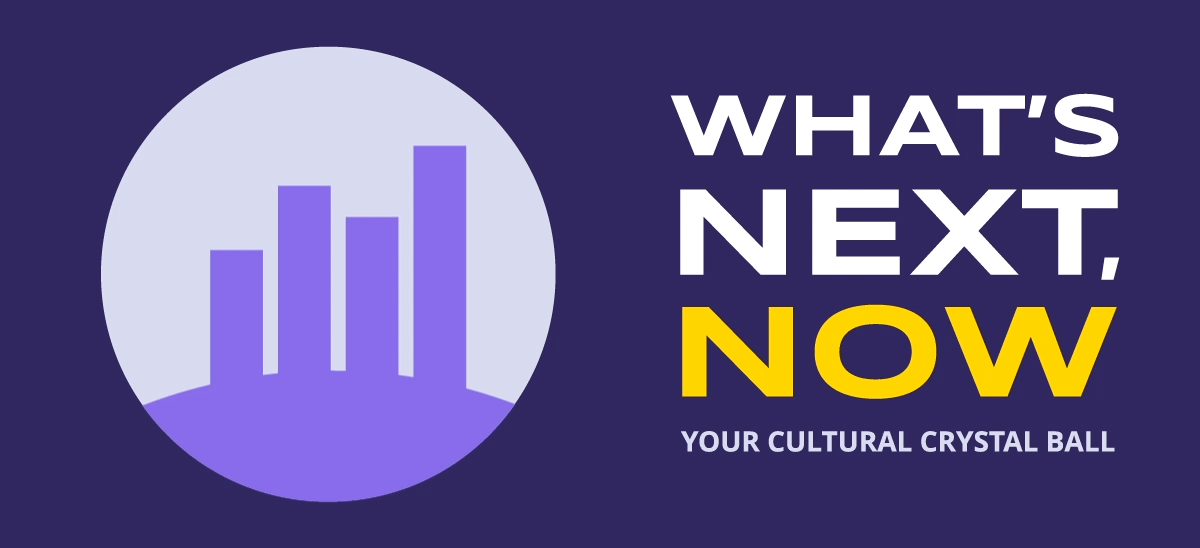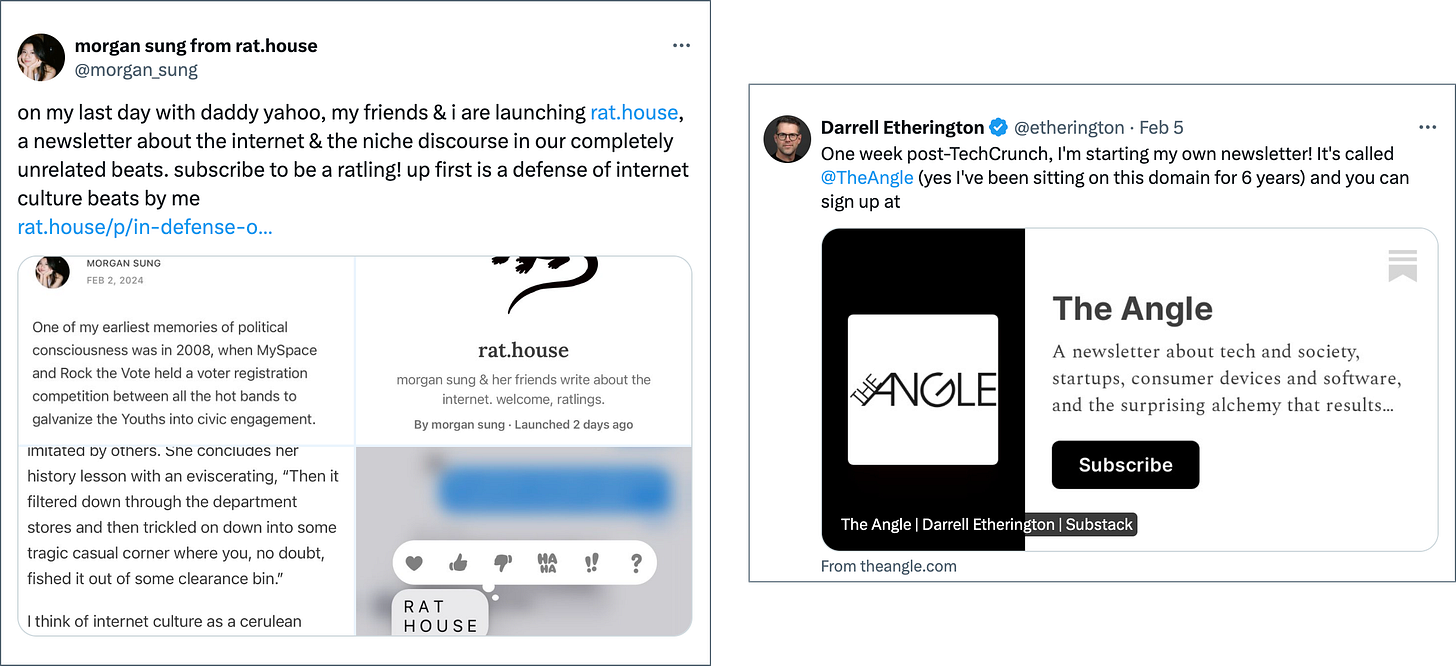What's Next, Now: February 2024
This month, our crystal ball predicts a splintering news landscape, a growing rift in trust in AI, a new prioritization on sleep, and more.
We’ve been following the trend of newsroom cuts since 2020, when more than 16,000 journalists lost their jobs. But newsrooms don’t seem to be adjusting to the new normal like they could have over the past four years, and journalism jobs are continuing to hit the cutting room floor. In January of this year alone, more than 500 journalists were laid off, from major news outlets like the Wall Street Journal, popular online publications like TechCrunch and Business Insider, news startups like The Messenger, and local outlets like LA Times and the Washington Post.
With a market in continuous turmoil, many journalists hit by layoffs have been forced to join the niche and independent media landscape. For example, former TechCrunch managing editor Darrell Etherington announced a new newsletter focused on tech news, and TechCrunch digital culture reporter Morgan Sung launched a newsletter about the internet — both hosted on popular newsletter platform Substack, which now boasts more than 3 million paid subscribers.
The niche media landscape has been growing over the past few years, both from former reporters creating independent content and non-traditional journalists entering the market. Even traditional media is starting to look to niche news as legitimate competition — so much so, that the New York Times is creating an entire beat to report on “non-traditional media organizations, including those behind newsletters, podcasts and new video formats.”
The growth of the independent media market gives journalists a chance to report on their own terms, without answering to any publisher agendas or metrics-hungry hedge funds. But it’s also created a splintered landscape that makes it harder for consumers to find news they can trust, and for brands to connect with qualified journalists who can help tell their story. The quality of traditional news will suffer as journalists are forced to cover more beats they are unfamiliar with, and independent media is often difficult to locate if you’re not already in the know, leaving room for bad actors. These factors will place additional onus on brands engaging with media to operate with precision to effectively reach the audiences that matter most to them.
Are the risks of AI starting to outweigh the rewards? Some consumers and businesses are starting to think so.
Edelman’s recently-released Trust Barometer revealed tech innovations like AI are creating a new rift in trust between consumers and institutions. While 22% of survey respondents trust that innovation is well-managed, nearly twice as many believe businesses, technology creators, and governments poorly manage innovation. When it comes to AI, 43% of respondents said they believe the tech is poorly managed, and 35% said they rejected AI innovation outright.
Some businesses are starting to pull back, too. At Davos, CEOs across industries named AI as one of the biggest threats to business this year (though they also labeled it as one of the biggest opportunities). And some are rejecting AI altogether — Gartner research revealed around 20% of brands will start leaning into being AI-free as a differentiator. These brands are going “acoustic” in hopes to appeal to AI skeptics, prioritizing authenticity and human-first positioning.
The key to establishing trust in AI is knowledge and experience with it. Businesses can sustain trust while remaining innovative by helping consumers understand what AI is and how they are using it. Brands should be transparent about what data is being collected for use in AI tools, where AI is being used, and what for.
Twenty-year-olds are trading in their vodka sodas for the latest TikTok trend — a sleepy girl mocktail. The #SleepyGirlMocktail tag saw more than 570 million earned media impressions and 50 million TikTok views. Composed of tart-cherry juice, magnesium powder, and soda water to promote better sleep, the wellness drink exemplifies a trend originating from the pandemic that is taking shape in a new way.
On top of the drink’s popularity, young professionals are tucking into bed earlier and prioritizing the benefits of a full night's sleep. Findings from the 2022 American Time Use Survey data by RentCafe revealed that 20-year-olds are getting an average of nine hours and 28 minutes of sleep per night — up an entire 8% from report findings in 2010.

While sleep may not have been prioritized in the past, this daily activity is being rebranded as a luxury. The rise of wearable wellness technology has perpetuated this — from the Oura Ring (retailing at $300 a piece) to the Hatch alarm clock (retailing at $200). The sleep-focused wearable technology space is only expected to grow.
Although we’re approaching the four-year mark since the pandemic caused global shutdowns, we’re still seeing widespread impacts throughout all facets of our lives. Millennials are so fixated on protecting their peace, the latest research from Ford revealed more than half of millennials worldwide are willing to sacrifice 20% of their paycheck to achieve a better work-life balance. People are enjoying a slower-paced life and reverting to less tech-focused hobbies like knitting, sewing, and reading (and sleeping!) to escape grind culture.
The business of AI is booming — and so are the businesses behind it. AI is a resource-heavy technology, and markets have been growing and changing to accommodate AI’s explosion.
AI feeds on data. As businesses continue to build, train, and deploy new AI models, they’ll need increasing amounts of data. A growing market of data brokers and vendors is cropping up to connect businesses with the massive data sets AI demands.
AI also needs a place to live, and for many businesses, that’s the cloud. Major cloud vendors like Google and Amazon have reported increasing revenues as companies invest in cloud for their AI experiments — Google’s cloud services are up 26% and AWS reported 13% growth. Chipmaker NVIDIA has also seen an AI-powered boost, with growth of over 400% in its data center business, which includes the graphics cards used to power generative AI tools like ChatGPT.
But it’s not just technological resources that AI needs — AI is also commanding an increasing amount of natural resources, as well. According to its latest environmental report, Microsoft’s water consumption spiked 34% year over year to nearly 1.7 billion gallons (the equivalent of more than 2,500 Olympic swimming pools), which can be attributed to the company’s AI research. And AI requires massive amounts of energy to train and run — one estimate claimed that by 2027 AI servers could use as much as 134 terawatt hours of energy annually, the same amount as countries like Argentina, the Netherlands, and Sweden.
Consumers are savvy enough to know what kind of resources go into AI. For businesses leaning into the tech, it’s important to get ahead of any consumer demands by remaining transparent about the data, investment, and energy required to power AI.
You’ve either seen it on TikTok or experienced it in real life — the tweens are taking over Sephora. Don’t believe us? Search #sephorakids on the app.
Gen Z’s obsession with Sephora points to a larger trend: age anxiety. It’s not a new phenomenon, as skin care companies have been marketing anti-aging serums for decades. But young millenials and elder Gen Z are just beginning to show signs of aging, and in the world of airbrushed social media, skincare routines are hot right now. While it may be the 20-somethings leading the creation of skincare routine videos, their audience is getting younger — tweens as young as 10 may be posing as 13 to gain access to social media.
The Gen Z fixation on skincare and anti-aging regimens owes a lot of credit to social media, and TikTok in particular. On TikTok, the #maintenanceroutine hashtag has received more than 26 million views, #skincareroutine has 81.6 billion views, and #preventativebotox has 61.3 million.
Brands are taking note. Statista data shows that the baby and child skincare market is expected to reach $380m in market volume worldwide by 2028. Skincare company Bubble Skincare already works with about 2,000 12 to 14-year-old ambassadors.
It really shouldn’t be a surprise that Gen Z is “growing up” faster than other generations. In the early 2000s, the mall, full of tween-focused stores like Limited Too (Justice) and Claire’s, were the hottest places to be for a soon-to-be teen. Malls have been on the decline since the pandemic, limiting age-appropriate third spaces for tweens and teens and forcing them to navigate other spaces more traditionally reserved for adults. Brands should be mindful to keep a space for tweens in their marketing, and be intentional with their audience demographics. If you’re only targeting kids or adults, who are you leaving out?
 Tiktok failed to load.
Tiktok failed to load.Enable 3rd party cookies or use another browser
The massive growth of Ozempic is starting to make food producers worry about falling profits as consumers buy less food. But producers of natural, blood-sugar friendly snacks might see the opposite effect.
If you’re still holding on to your cable subscription for the sports channels, it might be finally time to cut the cord. ESPN, Fox, and Warner Bros plan to launch a joint sports streaming service later this year, combining all their live sports offerings into one bundle.
Gen Z and Millennials are responding to the vibecession by both saving money (loud budgeting) and spending money (doom spending).
Want to hear more? Check out our free newsletter The Spark for the biggest digital marketing updates, tips, and trends in your inbox. From SEO to social media to content marketing, we’ve got you covered.
Copyright © 2024 Tier One Partners is a women-owned full-service PR, content, and digital marketing agency. We work with innovators in B2B and B2C technology, digital healthcare, financial services, energy tech, and manufacturing to develop award-winning creative, data-driven strategies that propel them to industry leader status. From day one, we’re committed to earning our clients’ trust, sharing their vision, and embedding their purpose into everything we do. To learn more, visit wearetierone.com.




















